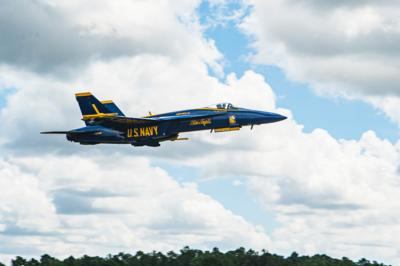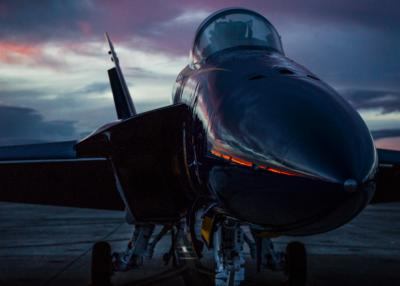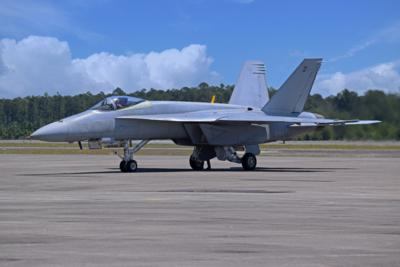Navy Made The Decision To Transition The Blue Angels To The Super Hornet In 2018
The first of 18 F/A-18E Super Hornets touched down at Naval Air Station Pensacola, Fla., July 27 ushering in a new era for the Navy Flight Demonstration Squadron, or Blue Angels, as they retire the legacy F/A-18 Hornet that has wowed audiences for 35 years.

This transition was supported from the earliest stages by NAVSUP Weapon Systems Support.
The first of 18 F/A-18E Super Hornets touched down at Naval Air Station Pensacola, Fla., July 27 ushering in a new era for the Navy Flight Demonstration Squadron, or Blue Angels, as they retire the legacy F/A-18 Hornet that has wowed audiences for 35 years. This transition was supported from the earliest stages by Naval Supply Systems Command (NAVSUP) Weapon Systems Support (WSS).
"Acquiring our first Super Hornet is a momentous step in our inevitable transition scheduled for later this year and it required a herculean effort to get these fleet jets ready for our team," Cmdr. Brian Kesselring, commanding officer and flight leader of the Blue Angels, said in a statement. "We would like to especially thank the teams at Boeing, Chief of Naval Air Training Command, Naval Air Systems Command, Fleet Readiness Center Southeast, and Naval Supply Systems Command Weapon Systems Support."
The Navy made the decision to transition the Blue Angels to the Super Hornet in 2018.

“In reality, the behind the scenes transition began years ago,” said Carol Kotowski, NAVSUP WSS F/A-18 Integrated Weapon Systems Team (IWST) deputy director. “The transition to Super Blues aircraft is a complex process involving many entities in the Naval Aviation Enterprise (NAE) including NAVSUP WSS.”
The primary NAVSUP WSS contribution toward the Blue Angels transition to the Super Hornet was the development of an on-site parts inventory to support training and shows. The NAVSUP WSS F/A-18 IWST, along with NAVSUP WSS Retail Allowancing and Material Budget departments reviewed existing fleet demand to build the inventory, in conjunction with the Super Blues transition team and fleet Super Hornet supply and maintenance personnel.
“The reviewed data was modeled identifying specific component range and depth levels of NAVSUP managed aviation components, and DLA managed consumables to support Blue Angels Super Hornet flight operations for training and shows throughout the country,” said Maria Kardas, NAVSUP WSS F/A-18 IWST Blue Angel supply lead. “Material requirements recommendations resulting from the modeling were planned, budgeted and procured to be delivered and on site in Pensacola no later than January 2021 to support Super Hornet flight requirements leading up to the start of the 2021 show season.”
The aircraft the Blue Angels will be receiving are early production fleet aircraft transferred from Navy squadrons.

The aircraft will be modified and refurbished by the Boeing Company’s Cecil Field facility near Jacksonville, Fla., prior to transferring to the Blue Angels. The modifications include installing the smoke generation system, civilian compatible navigation equipment and cameras. In addition, the Super Hornets will be repainted to the Blue Angel’s signature blue and gold colors.
The Blue Angels are set to get all of the Super Hornets by the end of this year with the plan that the team will be ready to perform with them in 2021 for the team’s 75th Anniversary. The larger, louder, more powerful and more maneuverable Super Hornets will bring new elements to a Blue Angels performance and NAVSUP WSS plays a critical role in keeping them flying.
 ANN's Daily Aero-Term (04.24.24): Runway Lead-in Light System
ANN's Daily Aero-Term (04.24.24): Runway Lead-in Light System ANN's Daily Aero-Linx (04.24.24)
ANN's Daily Aero-Linx (04.24.24) Aero-FAQ: Dave Juwel's Aviation Marketing Stories -- ITBOA BNITBOB
Aero-FAQ: Dave Juwel's Aviation Marketing Stories -- ITBOA BNITBOB Classic Aero-TV: Best Seat in The House -- 'Inside' The AeroShell Aerobatic Team
Classic Aero-TV: Best Seat in The House -- 'Inside' The AeroShell Aerobatic Team Airborne Affordable Flyers 04.18.24: CarbonCub UL, Fisher, Affordable Flyer Expo
Airborne Affordable Flyers 04.18.24: CarbonCub UL, Fisher, Affordable Flyer Expo





